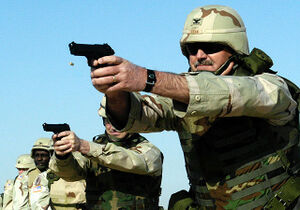Brandishing (nonfiction): Difference between revisions
Jump to navigation
Jump to search
No edit summary |
No edit summary |
||
| Line 1: | Line 1: | ||
[[File: | [[File:Soldiers with 9 mm pistols.jpg|300px|thumb|US soldiers training with 9 mm pistols.]]'''Brandishing''' is displaying a [[weapon]] in order to intimidate another person. | ||
== Etymology == | == Etymology == | ||
Revision as of 16:46, 14 June 2016
Brandishing is displaying a weapon in order to intimidate another person.
Etymology
brand (n.)
Old English brand, brond "fire, flame; firebrand, piece of burning wood, torch," and (poetic) "sword," from Proto-Germanic *brandaz (source also of Old Norse brandr, Old High German brant, Old Frisian brond "firebrand, blade of a sword," German brand "fire"), from root *bran-/*bren- (see burn (v.)).
- Meaning "identifying mark made by a hot iron" (1550s)
- Broadened by 1827 to "a particular make of goods."
- Brand name is from 1922.
brand (v.)
- c. 1400, "to brand, cauterize; stigmatize," originally of criminal marks or cauterized wounds, from brand (n.).
- As a means of marking property, 1580s;
- Figuratively from c. 1600, often in a bad sense, with the criminal marking in mind. Related: Branded; branding.
Source: http://www.etymonline.com/index.php?term=brand
Fiction cross-reference
The Brandisher circa 1703, prominently displaying a one-handed axe-and-pick weapon.
Green Lanterns brandishing their power rings.


